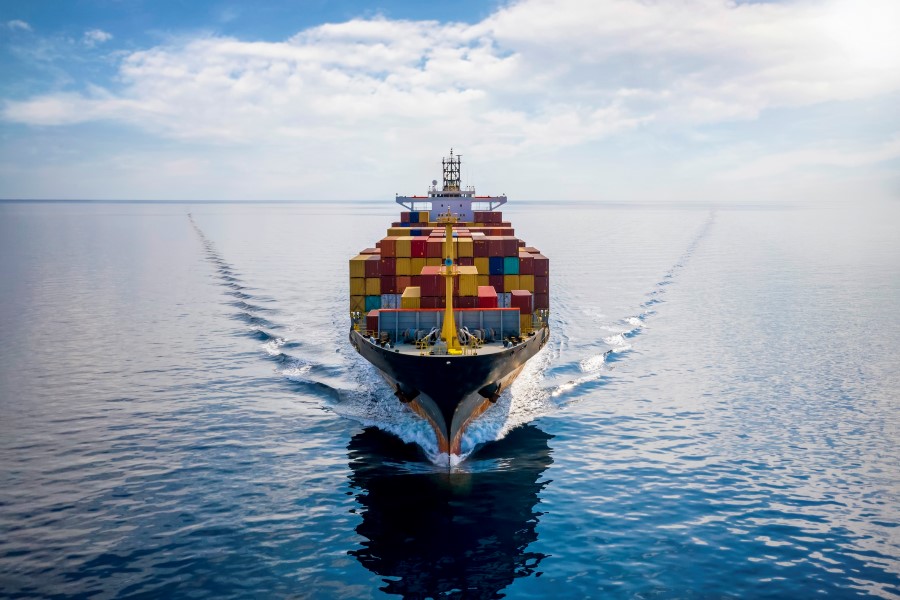
Businesses are being urged to lock in fixed rates and space on container ships as world events continue to cause havoc with international freight.
Establishing and honouring agreements with freight providers – whether that’s the carrier itself or through a forwarder — is the safest way to ensure containers get on to ships, Tom Holyman, General Manager Ocean Freight, Australia and New Zealand, Toll Group, told those who attended our recent webinar, World Freight and Logistics – the impacts on your business.
“That means you’ve entered into a contract with fixed rates and generally with fixed-space commitments,” Mr Holyman said.
“The contract binds the carrier or your freight provider into delivering on that.”
Mr Holyman said it was imperative for businesses to act now and to honour contracts to foster loyalty.
“Enter into the contract in the low season now and honour that contract through the high season,” he said.
“Those who abandon contracts now are setting a precedence for carriers to abandon the contract later in the year when the importers and exporters most need their space in the peak season.
“We would urge companies to not think where today’s spot market is – which is a temporary and seasonal aberration and related to the Covid-19 situation in China – but to think about where you were in October and November last year, screaming for space and a commitment to uplift the container.
“By the time we reach July, there will be almost no chance to lock into contract pricing. Even if you were to try, the conditions will likely be unfavourable.
“Honouring that named account contract that you’ve entered into is the surest way to ensure your booked container gets on a ship.”
However, it’s still not a cast-iron guarantee, with issues such as Covid-19 or port congestion leading carriers and freight providers to declare force majeure.
Further, businesses with small volumes face an even greater battle in persuading carriers or freight providers to commit to a contract rate.
“For those who do have that volume, we would urge you to lock into contract pricing, even though the spot market may offer some favourable pricing at the moment,” Mr Holyman said.
Australian businesses and logistics are being impacted by numerous factors including ongoing Covid-19 issues in China, conflict in Ukraine and relentless global demand for products.
The recent Covid-19 outbreaks in China have reset the whole global supply chain back to where it was at the middle of last year.
The biggest disruptions regarding supply and logistics are occurring in and around Shanghai.
“The lockdowns in Shanghai have meant that manufacturing is not occurring and the ability of manufacturers to deliver their goods to port and have them exported is severely curtailed,” Mr Holyman said.
Truck drivers impacted by Covid-19 are required to isolate for seven days which has resulted in a shortage of drivers and a reduction in productivity.
Goods are being redirected to other ports, including nearby Ningbo, China’s second-largest port.
“The problem is that everyone had the same idea and as the goods were redirected away from Shanghai towards Ningbo, that port has become congested to the point where many of the Ningbo facilities are refusing to receive any new cargo because they are trying to get rid of the backlog.
“So, the whole Shanghai-Ningbo region is congested.
“The ports are working normally; it’s the manufacturing and the ability to pack and deliver the cargo to the ports and to pick cargo up from the ports for those who are exporters which is being curtailed.
“It’s more of a transport land-based issue than it is a sea-based one.”
Notwithstanding embargoes, the impact of this conflict on international freight is fairly localised and revolves around vessels not being able to enter the Black Sea to service Ukraine and Russian ports.
It is not until the start of next year that oil prices are expected to rise.
Shipping prices are currently more than four times higher than they were before the start of the pandemic.
A 40ft container now costs just under $8000, with prices expected to increase in coming weeks to about $10,000.
In contrast, rates were below $2000 at the start of 2020.
The higher rates will become permanent, Mr Holyman warned.
“Don’t imagine that pricing for ocean freight will return to the sorts of levels that we saw in 2019 pre-Covid,” he said.
“Container ocean freight is very much a pure supply and demand business. At the moment, we’re seeing an imbalance, which is largely on the supply side. I don’t see the supply side recovering for another 12 months and therefore I don’t see supply-demand rebalancing for another 12 months. This means it will take that long to see a return to more reasonable pricing.
“We’re now one quarter and a month into the new calendar year and certainly on the Australian New Zealand (ANZ) trades, particularly those out of the big supply areas — Asia, in particular, but also out of North America and Europe — the container ocean business is still significantly disrupted operationally.”
A significant spike in demand for goods last year contributed to supply chain disruptions, with the supply side suffering the most.
“What took some months to wind up into the kind of supply chain disruptions that we are seeing now will take many months to unwind,” Mr Holyman said.
“It’s not something that will happen overnight.”
Last month, more than two in five (41%) businesses were experiencing supply chain disruptions, according to the Australian Bureau of Statistics.
This compares to just 30% in April 2021.
“Much of the world’s capacity of container shipping has been impacted by an inability to fully deploy the full capacity of those vessels,” Mr Holyman said.
“For example, most container shipping services in the world work on a seven-day fixed schedule. Last year, some of the services weren’t able to achieve the seven-day or 52 sailings in the year.
“In fact, they were only able to achieve as little as 44 sailings. So, already, 15% of the world’s capacity in that instance was lost.
“That’s why we are seeing a decline in supply, even though we are not seeing ships themselves being scrapped at the rate they were pre Covid.”
An Ai Group survey of CEOs published at the end of last year showed building up inventory was the No.1 strategy employed by businesses to combat supply chain disruptions.
Many businesses have also been forced to find new suppliers, Ai Group’s Head of Industry Development and Policy Louise McGrath said.
“There has never been a time when carriers have been more unreliable than now,” Mr Holyman said.
“Or, put another way, never have shipping companies provided such poor services and made so much money at the same time, which is a reflection of the supply-demand imbalance.”
Reliability is measured by the actual arrival date of vessels against their advertised arrival date.
In January this year, reliability dropped to a low of 30% and rose only slightly to 35% the following month.
In contrast, carriers were recording 70%-80% reliability in pre-Covid 2019, with less than five days of delays.
Today, delays of between 7-8 days are being recorded, largely because seven of the top 10 ports are in China.
A further potential supply-side disruptor is the International Maritime Organisation’s commitment to further reduce greenhouse gases.
Because of this, some vessels may have to steam at slower speed which will extend transit times between ports for goods.
High-level space is “very tight” which means it is difficult to obtain bookings on the spot market.
Further, the spot market is expected to increase this month.
Significant labour disruptions are also causing issues at container terminals in Australia and New Zealand, bringing productivity decline, delays and congestion.
“In the second half of the year, which is the traditional high season for ANZ businesses, I would expect there to be a supply-demand imbalance, with supply quite short,” Mr Holyman said.
“Therefore, it’s imperative that you lock into committed space and pricing to protect your businesses, if you can.”
The Australian Industry Group continues to monitor and predict world freight and logistics and works with the Federal Government to best support our members.

Wendy Larter is Communications Manager at the Australian Industry Group. She has more than 20 years’ experience as a reporter, features writer, contributor and sub-editor for newspapers and magazines including The Courier-Mail in Brisbane and Metro, the News of the World, The Times and Elle in the UK.